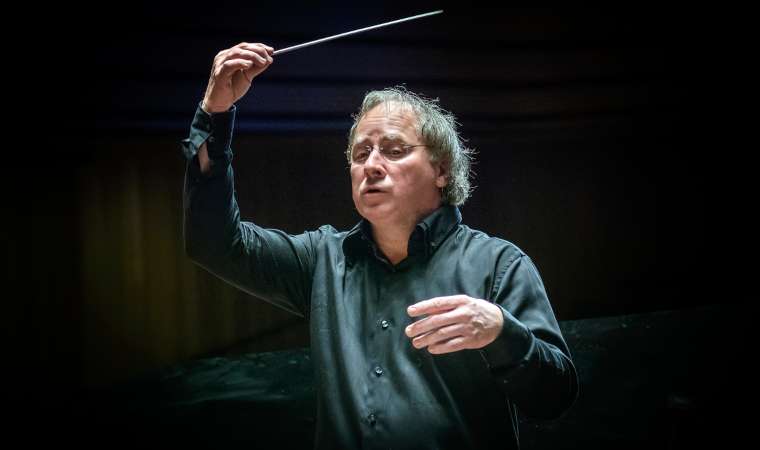This article was updated in October 2024.
Béla Bartók's Concerto for Orchestra is a piece that almost didn’t come to fruition. The Hungarian composer fled his home country in the wake of World War 2, settling in the United States in 1940, where he spent the final five years of his life. These were difficult years for him, marred with poor health and often struggling to make ends meet. Some have conjectured that his String Quartet no. 6, completed in 1939, could have been his final work had it not been for a commission from the Koussevitzky Music Foundation. The result of this commission was the Concerto for Orchestra, that in turn spawned a handful of late-period gems, including the Third Piano Concerto.
Serge Koussevitzky himself conducted the premiere with the Boston Symphony in 1944, garnering favourable reviews. And of the Chicago premiere a few years later, Felix Borowski wrote in the Chicago Sun that the work was “of more than ordinary worth… modern, indeed it is, but there are ideas – often very beautiful ideas – in the course of it. The orchestration is rich and colourful, frequently with new and beguiling textures.” Structurally, the Concerto essentially unfurls as a five-movement symphony: its designation as Concerto refers to the abundance of colourful solo passages across the orchestra – a fine opportunity for any ensemble to show its mettle.
On his impetus to compose, Bartók wrote that “my true guiding principle...[is] the ideal of the brotherhood of peoples, despite war and all conflict. It is this ideal which I work with all my power to serve through my music; this is why I do not avoid any influence, be it from Slovak, Romanian, Arabic or any other source” – a quote as timely as ever in acknowledging the unique ability of music to speak across one culture to another.
It is with this spirit of cross-culturalism that Concerto Budapest is bringing the music of Bartók and others to Asia during a tour under the baton of chief conductor and artistic director András Keller.
Concerto Budapest boasts a history of over a century of music-making, dating back to when Bartók was just a young man. 2007 marked the ensemble’s centennial, at which point Keller – founder of the Keller Quartet – was appointed to his current role, shaping the organisation into the dynamic force it is today. The tour brings the orchestra to Thailand and China, also serving to mark the 70th anniversary of the establishment of diplomatic relations between China and Hungary. In addition to the Concerto for Orchestra, the tour repertoire also includes works by Liszt, Tchaikovsky, and Dvořák, as well as a program of opera arias featuring soprano Angela Gheorghiu.

Given its long history in Hungarian musical life, it is certainly appropriate that Bartók’s Concerto for Orchestra is featured prominently on the tour programme: this is one of the most significant scores from a composer that is due to receive attention from orchestras around the world next year, in commemoration of the 75th anniversary of his death. A look into Bachtrack’s classical music statistics confirms the work’s stronghold in the repertoire – Bartók has consistently ranked in the top 30 most frequently performed composers since Bachtrack started recording statistics in 2012, and the Concerto for Orchestra counts amongst his most often programmed works, in some regards rivalling only Stravinsky’s Rite of Spring as a 20th-century orchestral work firmly in the standard repertoire.
But what accounts for its enduring appeal? Broadly speaking, the Concerto is an archetypal journey from darkness to light, so common in classical music (think of Beethoven’s Fifth Symphony). As the composer himself put it, “the general mood of the work represents – apart from the jesting second movement – a gradual transition from the sternness of the first movement and the lugubrious death-song of the third, to the life-assertion of the last one.”
Matters open with an imposing introductory movement, cast in sonata form. The scherzo-like second movement, bearing the subtitle “Giuoco delle coppie” (“Game of Pairs”), offers quite a contrast in its playfulness and striking orchestral timbres. A central Elegia serves as the heart of the piece, quintessential Bartók in its use of “night music”, the composer’s idiosyncratic language for evoking the atmosphere of the night. Another lighter movement follows, giving the work a certain degree of symmetry. Titled “Intermezzo interrotto”, the eponymous interruption comes from the glaring injection of a theme generally thought to invoke Shostakovich’s Seventh Symphony (though some commentators have pointed to other sources, including Lehár). The finale is a big-boned, high-octane affair, a good performance of which ensures a powerful impact.
Musicologist and Bartók specialist David Cooper keenly notes in his 1996 Cambridge University Press book on this work that “the essence of Bartók’s music [is] its precarious tightrope balance between urban art music and rural popular music, tonality and atonality, chaos and order.”
These sharp contrasts are achieved in remarkable balance throughout the Concerto for Orchestra, and in so doing, the work attains a popular appeal without compromising artistic integrity or ambition. As a pioneer in the field of ethnomusicology along with compatriot Zoltán Kodály, Bartók had a deep reverence for folk music traditions, seamlessly juxtaposing the vernacular with classical forms as in the Concerto, and moreover, appealing to music’s potential to reach over cultural barriers.
In Cooper’s analysis of the Concerto, he points out the interpolation of folk themes from Hungary, elsewhere in Eastern Europe, and as far away as North Africa. This seamless blending of disparate sources cast in a familiar classical structure was central to Bartók’s project as a composer, and the Concerto for Orchestra is perhaps the culmination of that ambition. In the Concerto, different cultures flourish together musically, transcending the notion of man-made borders, and the work has spoken forcefully to audiences as diverse as its source material since its inception.
Doubtless Bartók would have been delighted to know of his own music sounding in China and Thailand. As Keller puts it, “Bartók was able to enliven this wonderful idea [of multiculturalism] in his Concerto for Orchestra. This is why his last symphonic work, to my mind, can be compared in significance to Beethoven's Ode to Joy. Nevertheless, our everyday life is missing this notion perhaps the most these days. I am certain that whoever meets this music becomes richer than was before. I hope that a great many people will come to know this eternal work of art along the Asian tour of Concerto Budapest in October.”
Click here to see all upcoming concerts of Concerto Budapest.
This article was sponsored by Concerto Budapest.


